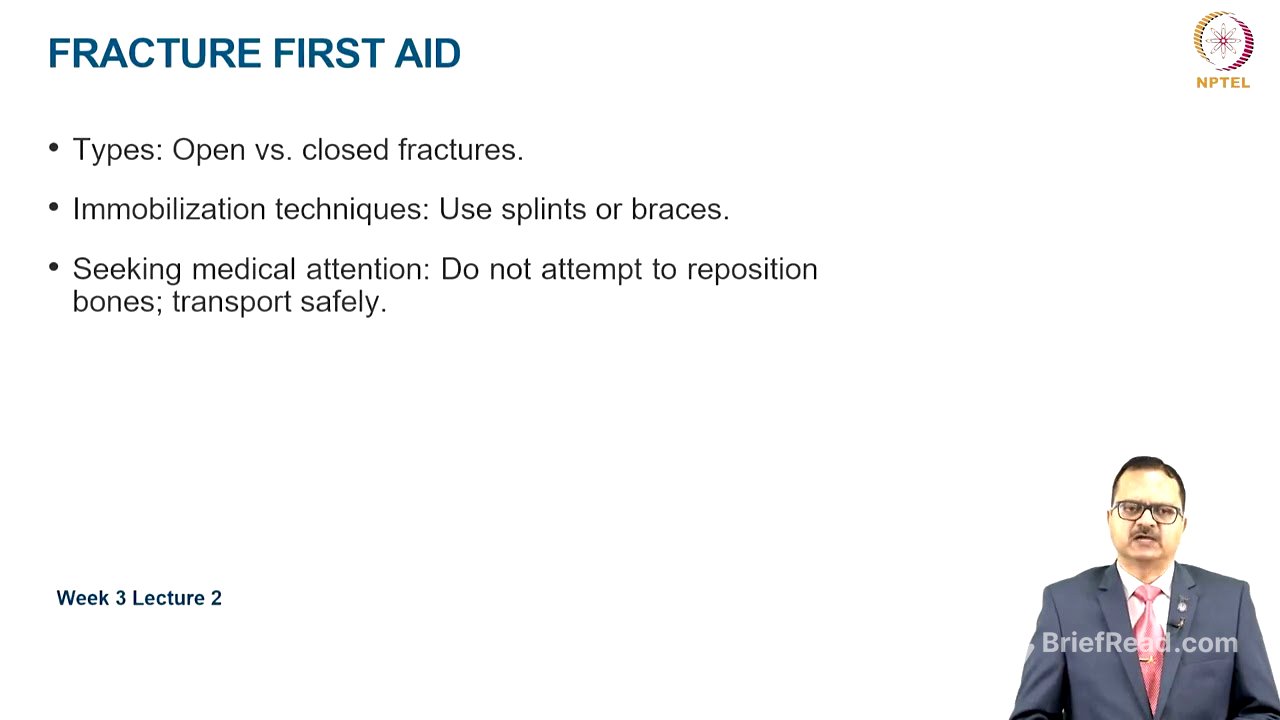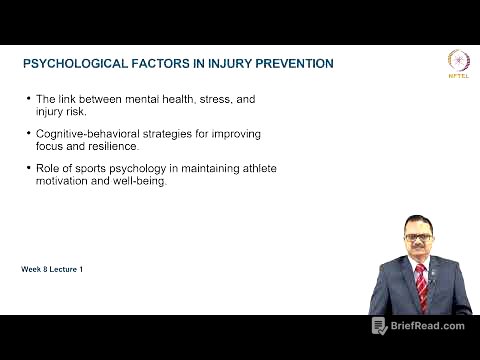TLDR;
This lecture provides an overview of immediate treatment and first aid for sports injuries, emphasizing the importance of quick response to minimize complications and speed up recovery. It covers the classification of injuries, principles of first aid including Dr. ABC, PRICE, and POLICE protocols, and specific management techniques for common sports injuries like sprains, fractures, head injuries, and environmental-related conditions. The lecture also touches on the roles of first responders, return-to-play guidelines, and future trends in sports first aid.
- Importance of immediate treatment to minimize complications and reduce return-to-play time.
- Key first aid protocols: Dr. ABC, PRICE, and POLICE.
- Management of various sports injuries, including fractures, sprains, head injuries, and environmental conditions.
Introduction and Classification of Sports Injuries [0:15]
The lecture focuses on the immediate treatment and first aid for sports injuries. The importance of immediate treatment in sports injuries is to minimize complications and reduce the return-to-play time. The goals of immediate treatment are to reduce pain, prevent further damage, promote recovery, and ensure a safe return to play. Sports injuries are classified into acute injuries, which have a sudden onset due to impact or trauma, and chronic injuries, which develop over time due to overuse.
Principles of First Aid: Dr. ABC Protocol [2:09]
The principles of first aid in sports injuries involve a primary assessment to ensure safety, check the level of consciousness, and assess vital signs, followed by a secondary assessment to determine the injury type, severity, and need for medical intervention. The Dr. ABC protocol is used for emergency response: Danger (ensure the environment is safe), Response (check the athlete's level of consciousness), Airway (ensure the airway is clear), Breathing (check for normal breathing), and Circulation (assess the pulse and check for severe bleeding). Any bleeding should be addressed immediately.
PRICE and POLICE Protocols for Acute Injuries [3:36]
The PRICE protocol for acute injuries includes Protection (prevent further injury with splints or braces), Rest (limit movement to the injured area), Ice (apply ice for 15-20 minutes every few hours), Compression (use bandages to control bleeding), and Elevation (raise the injured limb above the heart). The POLICE principle, a modified approach, stands for Protection, Optimal Loading (gradual controlled movement instead of prolonged rest), Ice, Compression, and Elevation.
Management of Sprains, Strains, and Fractures [5:02]
Sprains and strains are graded from one to three, with grade one being mild overstretching, grade two a partial tear, and grade three a complete tear. Treatment involves PRICE, POLICE, rehabilitation exercises, and progressive loading. For fractures, which can be open or closed, immobilization is crucial using splints or braces in as normal an anatomical position as possible. Medical attention should be sought immediately, and no attempt should be made to reposition the bones.
Dislocations, Subluxations, and Head Injuries [6:03]
Dislocations and subluxations are indicated by deformity, swelling, and inability to move the joint. First aid involves immobilization and seeking immediate medical attention, with no attempts to relocate the joint manually. For head injuries and concussions, signs include headache, dizziness, nausea, confusion, and memory loss. Assessment is done using the SCAT 6 tool, ideally with a pre-game baseline. The athlete should be removed from play immediately and monitored for worsening symptoms, with return to play only after clearance by a medical professional.
Muscle Cramps, Contusions, and Wound Care [7:08]
Muscle cramps are caused by dehydration, electrolyte imbalance, or overuse, and are treated by hydrating with fluids containing electrolytes, stretching, and gently massaging the affected muscle. Heat may be applied for tightness or ice for pain relief. Contusions and bruises are managed by applying ice to minimize swelling, protecting the area from further impact, and monitoring for compartment syndrome. Wound care involves cleaning with sterile saline or antiseptic solution (Savlon or betadine), applying an antibiotic ointment, and covering with a sterile bandage, while monitoring for signs of infection.
Bleeding Control, Nosebleeds, and Environmental Injuries [8:24]
Bleeding control starts with direct pressure using a sterile dressing for 15-20 minutes, with the injured area elevated above the heart if possible. Arterial bleeding may require a tourniquet above the limb on a single bone area. For nosebleeds, the athlete should pinch the nostrils, lean forward, and apply ice to the bridge of the nose, avoiding tilting the head backward. Checking and controlling blood pressure is also crucial. Heat-related illnesses include heat cramps (hydrate, stretch, massage), heat exhaustion (cool, rehydrate, rest), and heat stroke (rapid cooling, hospitalization). Cold-related injuries include hypothermia (remove wet clothing, warm gradually) and frostbite (warm water immersion, gentle rewarming).
Spinal, Eye, and Dental Injuries [10:40]
Spinal injuries are recognized by loss of sensation and difficulty moving limbs. The athlete should be kept still, with the neck stabilized using a cervical collar and the spine with a spine board, while seeking emergency medical assistance. For eye injuries, a foreign object should be rinsed with sterile saline, the eye covered with a bandage, and medical assistance sought. Blunt trauma requires a cold compress without direct pressure, and chemical exposure requires rinsing with clean water for at least 15 minutes before seeking medical attention. A knocked-out tooth should be placed in milk or saline, and emergency dental care sought; a fractured tooth requires a cold pack and a visit to a dental surgeon.
Sudden Cardiac Death, First Responders, and Return to Play [12:06]
Sudden cardiac death in athletes is indicated by sudden collapse, no pulse, and no breathing, requiring immediate cardiopulmonary resuscitation and use of an automated external defibrillator. Early defibrillation is critical. First responders, including coaches, trainers, and medical personnel, are responsible for immediate care, injury stabilization, and coordinating emergency response. Return-to-play criteria include complete pain-free movement, full range of motion and strength compared to the other limb, and clearance by a healthcare professional if needed.
Future Trends and Take-Home Message [13:27]
Future trends in sports first aid involve wearable technology to detect injuries in real-time, on-field diagnostic tools like portable musculoskeletal ultrasound, and advances in regenerative medicine for faster healing. The key message is that quick response in sports injuries minimizes complications, reduces pain, and speeds up recovery. The Dr. ABC protocol is essential for emergency evaluation, PRICE and POLICE protocols should be followed, awareness of common injuries and first aid protocols is crucial, and proper first aid knowledge ensures athlete safety and optimal recovery.









